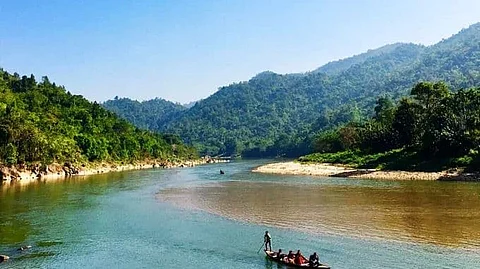
- Home
- Live Blog
- Breaking News
- Top Headlines
- Cities
- NE News
- Sentinel Media
- Sports
- Education
- Jobs

The Brahmaputra River, one of the largest rivers in the world, flows through the state of Assam in India and supports a unique and dynamic river island system. The Brahmaputra River islands, also known as "chars," are temporary or seasonal landforms that are created and destroyed by the river's constantly changing course.
These riverine islands are formed when sediment and sand are deposited by the river, creating new landmasses. However, due to the dynamic nature of the river, these chars are often eroded or submerged by the river's changing course.
Characteristics of Assam River Island Culture
Dynamic and ephemeral: The Brahmaputra River islands are constantly changing, with new islands forming and old ones disappearing due to erosion and sedimentation.
· Unique biodiversity: The unique flora and fauna of Brahmaputra River consist of a wide range of plant and animal species that are adapted to the dynamic and unpredictable environment of the Brahmaputra.
· Human settlements: Many of the river islands are inhabited by communities that have lived on the islands for generations, developing unique cultures and traditions.
· Agriculture and fishing: The river islands are used for agriculture, with crops such as rice, jute, and mustard being grown on the fertile soil. Fishing is also an important activity, with many species of fish being found in the waters of the Brahmaputra.
· Erosion and flood risk: The river islands are highly vulnerable to erosion and flooding, which can have devastating impacts on the communities that live on the islands.
Brahmaputra Floodplain Ecology
These islands, born of the river's constant flux and erosion, are home to a unique and fragile ecosystem that is both breathtakingly beautiful and perilously precarious. As the river's waters rise and fall with the seasons, the islands are constantly shifting, expanding, and contracting, creating a dynamic landscape that is both mesmerising and unforgiving. The Brahmaputra floodplain ecology, shaped by the relentless power of the Brahmaputra, is a true natural wonder, and one that is in urgent need of protection and preservation. The characteristics of the ecosystem are:
Vegetation
· Riverine forests: The islands support a variety of riverine forests, including tropical moist deciduous forests, tropical semi-evergreen forests, and grasslands.
· Wetlands: The islands have extensive wetlands, including marshes, swamps, and floodplain wetlands, which support a wide range of aquatic plants.
· Grasslands: The islands have grasslands that are dominated by tall grasses, such as Saccharumspontaneum and Imperatacylindrica.
Fauna
· Mammals: The islands support a variety of mammals, including the Bengal tiger, Asian elephant, greater one-horned rhinoceros, and several species of deer. The endangered species in Brahmaputra River islands find a safe haven in the unique ecosystem.
· Birds: The islands are an important habitat for a wide range of bird species, including the greater adjutant stork, lesser adjutant stork, and the Bengal florican.
· Fish: The islands support a diverse array of fish species, including the golden mahseer, giant catfish, and several species of carp.
Ecosystem Services
· Water filtration: The wetlands and forests of the islands help to filter the water of the Brahmaputra River, maintaining its quality and supporting aquatic life.
· Flood control: The islands help to regulate the flow of the Brahmaputra River, reducing the risk of flooding and supporting agricultural production.
· Soil conservation: The vegetation of the islands helps to stabilise the soil, reducing erosion and landslides and keeping the Brahmaputra floodplain ecology running.
Threats
· Erosion: The islands are highly vulnerable to erosion, which can lead to the loss of habitat and the displacement of communities.
· Habitat fragmentation: The islands are becoming increasingly fragmented due to human activities, such as agriculture and infrastructure development, which can lead to the loss of biodiversity.
· Climate change: Climate change is altering the hydrology of the Brahmaputra River, leading to changes in the frequency and severity of floods, which can have devastating impacts on the ecosystems and communities of the islands.
Examples of River Islands of Brahmaputra:
· Majuli Island: Located in the Brahmaputra River, Majuli Island is the largest river island in the world and is home to a unique culture and tradition.
· Umananda Island: Located in the Brahmaputra River, Umananda Island is a small island that is home to the Umananda Temple, a sacred Hindu site.
· Dibru-Saikhowa Island: Located in the Brahmaputra River, Dibru-Saikhowa Island is a protected area that is home to a wide range of plant and animal species.
Brahmaputra River conservation in Assam:
· Protected areas: Several protected areas, such as the Dibru-Saikhowa National Park and the Kaziranga National Park, have been established to conserve the unique biodiversity of the Brahmaputra River Island system.
· Community-based conservation: Community-based initiatives of Brahmaputra River conservation in Assam are being implemented to involve the local communities.
· Erosion control measures: Erosion control measures, such as the construction of embankments and the planting of trees, are being implemented to reduce the risk of erosion and flooding on the river islands.
ALSO WATCH: